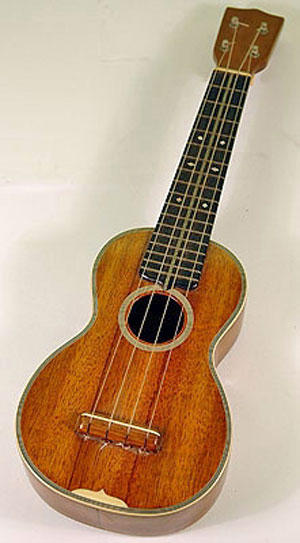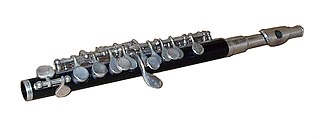Related Research Articles

The snare drum is a percussion instrument that produces a sharp staccato sound when the head is struck with a drum stick, due to the use of a series of stiff wires held under tension against the lower skin. Snare drums are often used in orchestras, concert bands, marching bands, parades, drumlines, drum corps, and more. It is one of the central pieces in a drum set, a collection of percussion instruments designed to be played by a seated drummer and used in many genres of music. Because basic rhythms are very easy to learn to play on a snare drum even for children, the instrument is also suitable for the music education for young children and a rhythm band.

The trombone is a musical instrument in the brass family. As with all brass instruments, sound is produced when the player's vibrating lips cause the air column inside the instrument to vibrate. Nearly all trombones use a telescoping slide mechanism to alter the pitch instead of the valves used by other brass instruments. The valve trombone is an exception, using three valves similar to those on a trumpet, and the superbone has valves and a slide.

The ukulele, also called a uke, is a member of the lute family of instruments of Portuguese origin and popularized in Hawaii. The tone and volume of the instrument vary with size and construction. Ukuleles commonly come in four sizes: soprano, concert, tenor, and baritone.

A transposing instrument is a musical instrument for which music notation is not written at concert pitch. For example, playing a written middle C on a transposing instrument produces a pitch other than middle C; that sounding pitch identifies the interval of transposition when describing the instrument. Playing a written C on clarinet or soprano saxophone produces a concert B♭, so these are referred to as B♭ instruments. Providing transposed music for these instruments is a convention of musical notation. The instruments do not transpose the music; rather, their music is written at a transposed pitch. Where chords are indicated for improvisation they are also written in the appropriate transposed form.
The musical term alto, meaning "high" in Italian, historically refers to the contrapuntal part higher than the tenor and its associated vocal range. In four-part voice leading alto is the second-highest part, sung in choruses by either low women's or high men's voices. In vocal classification these are usually called contralto and male alto or countertenor.

The piccolo is a smaller version of the western concert flute and a member of the woodwind family of musical instruments. Sometimes referred to as a "baby flute" or piccolo flute, the modern piccolo has the same type of fingerings as the standard transverse flute, but the sound it produces is an octave higher. This has given rise to the name ottavino, by which the instrument is called in Italian and thus also in scores of Italian composers.
Contrabass refers to several musical instruments of very low pitch—generally one octave below bass register instruments. While the term most commonly refers to the double bass, many other instruments in the contrabass register exist.

A pit orchestra is a type of orchestra that accompanies performers in musicals, operas, ballets, and other shows involving music. The term was also used for orchestras accompanying silent movies when more than a piano was used. In performances of operas and ballets, the pit orchestra is typically similar in size to a symphony orchestra, though it may contain smaller string and brass sections, depending upon the piece. Such orchestras may vary in size from approximately 30 musicians to as many as 90–100 musicians. However, because of financial, spatial, and volume concerns, current musical theatre pit orchestras are considerably smaller.

The sopranino saxophone is the second-smallest member of the saxophone family. It is tuned in the key of E♭, and sounds an octave higher than the alto saxophone. A sopranino in F was also described in Adolphe Sax's patent, an octave above an F alto (mezzo-soprano), but there are no known built instruments.

The A-flat (A♭) clarinet is the highest-pitched instrument of the clarinet family still manufactured. It is just over half the length of the common B♭ clarinet and pitched a minor seventh higher, a perfect fourth higher than the E♭ clarinet. As a transposing instrument it sounds a minor sixth higher than written, thus the lowest written note E3 sounds as concert C4 (middle C). Around the beginning of the 19th century, several small clarinets in different pitches appeared. The A♭ clarinet was adopted in European wind bands, particularly in Italy where it has appeared in Verdi's opera banda parts and survived to the present day in military bands. It is sometimes called for in contemporary classical music, in works by composers Béla Bartók and John Tavener, and in large clarinet choir works. It is manufactured by Italian makers Ripamonti and Orsi, and in Germany by Foag Klarinetten, Herbert Wurlitzer, and Schwenk & Seggelke.

The E-flat clarinet is a member of the clarinet family, smaller than the more common B♭ clarinet and pitched a perfect fourth higher. It is typically considered the sopranino or piccolo member of the clarinet family and is a transposing instrument in E♭ with a sounding pitch a minor third higher than written. The E-flat clarinet has a total length of about 49 centimetres (19 in).

Farro is a grain of any of three species of wheat, namely einkorn, emmer, or spelt, sold dried and cooked in water until soft. It is used as a side dish and added to salads, soups and stews.

The piccolo trumpet is the smallest member of the trumpet family, pitched one octave higher than the standard B♭ trumpet. Most piccolo trumpets are built to play in either B♭ or A, using a separate leadpipe for each key. The tubing in the B♭ piccolo trumpet is one-half the length of that in a standard B♭ trumpet. Piccolo trumpets in G, F, and even high C are also manufactured, but are rarer.

The viola pomposa is a five-stringed instrument developed around 1725. There are no exact dimensions applicable to all instruments used under this name, although in general the pomposa is slightly wider than a standard viola. It uses four viola strings, tuned conventionally (C-G-D-A), with the addition of a high E string, giving it a greater range than the orchestral viola; the trade-off comes in a sound which is slightly more resonant than a violin. The viola pomposa is played on the arm and has a range from C3 to A6 with fingered notes. Using harmonics, the range can be extended to C8 depending on the quality of the strings.

A guitalele, also called a ukitar, or kīkū, is a guitar-ukulele hybrid, that is, "a 1/4 size" guitar, a cross between a classical guitar and a tenor or baritone ukulele. The guitalele combines the portability of a ukulele, due to its small size, with the six single strings and resultant chord possibilities of a classical guitar. It may include a built-in microphone that permits playing the guitalele either as an acoustic guitar or connected to an amplifier. The guitalele is variously marketed as a travel guitar or children's guitar. It is essentially a modern iteration of the Quint guitar.
The Western concert flute family has a wide range of instruments.

Peg Leg is an album by jazz bassist Ron Carter, originally released on LP in 1978 and released on CD in 1991 by Fantasy Studios.

Collings Guitars is an Austin, Texas–based stringed instrument manufacturer. The company was founded in 1973 by BillCollings. In addition to acoustic guitars, Collings Guitars manufactures electric guitars, archtop guitars, mandolins and ukuleles.

Ukulele Songs is the second solo studio album by American singer and Pearl Jam frontman Eddie Vedder. It was released on May 31, 2011. The album is composed of original songs and new arrangements of several standards.
Treble describes tones of high frequency or high pitch, ranging from 6 kHz to 20 kHz, comprising the higher end of the human hearing range. In music, this corresponds to high notes. The treble clef is often used to notate such notes. Treble sound is the counterpart to bass sound. Examples of treble sounds include soprano voices, flute tones, and piccolos.
References
- ↑ Maz, Barry. "Ohana 'O'Nino' Sopranissimo Ukulele - REVIEW". GOT A UKULELE - Ukulele reviews and beginners tips.